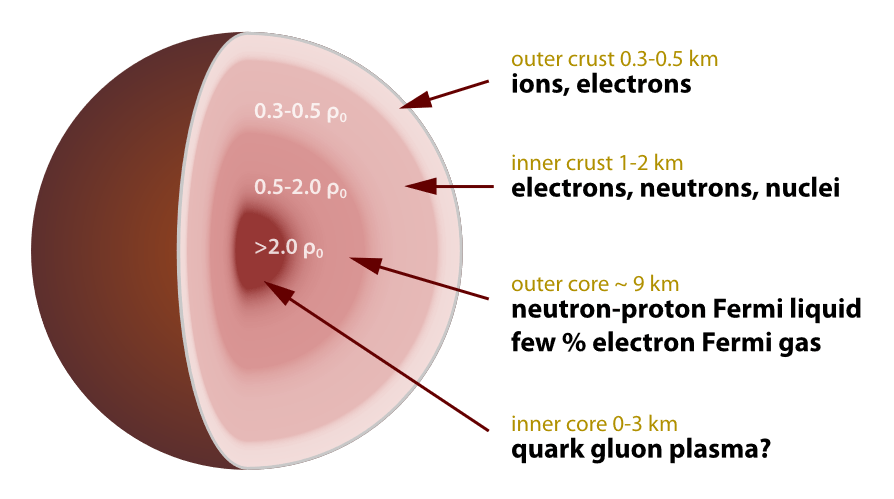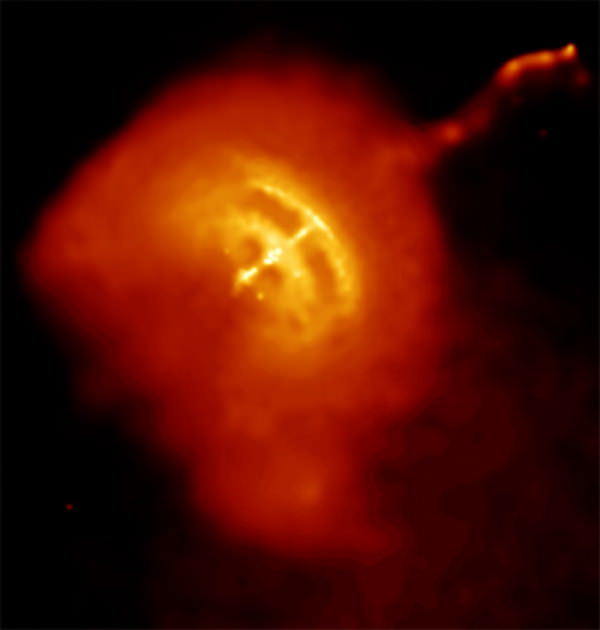What, exactly, is the inside of a neutron star like?
A neutron star is what remains after a massive star goes supernova. It’s a tightly-packed, ultra-dense body made of—you guessed it—neutrons. Actually, that’s not absolutely true.
Mathematical models show that neutron stars are made up of layers, and in those layers there are things other than just neutrons. But as you look deeper into a neutron star, you see more and more tightly-packed neutrons, and less of anything else. Once you get to the core, it’s mostly neutrons.

But it’s the ‘looking deeper into a neutron star’ that’s the problematic part. Nobody’s ever seen the inside of one.
Astronomers are stuck observing the exterior of neutron stars from a distance to try to understand them. Physics and mathematical models help, but there’s no substitute for actual observation. Luckily, sometimes neutron stars suffer “glitches,” and those glitches are an opportunity to learn something about these ultra-dense bodies.
Neutron stars rotate. They can also emit electromagnetic radiation from their poles, and when that radiation is pointed at Earth intermittently during the star’s rotation, we can see the beams. These neutron stars are called pulsars.
For the most part that rotation is very regular, and very rapid. But sometimes they rotate faster, and that happens when portions of the interior of the star move towards the exterior. For a brief astronomical moment, this glitch can let astronomers gain some insight into these perplexing objects.
In 2016, astronomers using the Mt. Pleasant telescope observed the Vela Pulsar glitching. The Vela Pulsar is about 1000 light years away, in the constellation Vela. It’s the brightest pulsar in the sky in radio frequencies, and it’s also the most well-known of all the glitching pulsars. Only about 5% of pulsars glitch, and Vela glitches about every three years.

This neutron star, which like all neutron stars is only several kilometers in diameter, normally rotates at about 11 times per second. But during the 2016 glitch, the star’s rotation sped up. This was the first time that it was observed glitching live.
In a paper published in the journal Nature Astronomy, a team of scientists re-analyzed the data from the 2016 glitch. The paper is called “Rotational evolution of the Vela pulsar during the 2016 glitch.” The first author is Dr. Greg Ashton of the Monash School of Physics and Astronomy.
The main finding of their re-analysis is that the glitch is more than just a simple increase of rotational velocity. The star rapidly spun up, before relaxing to glitch speed. According to the authors, the behavior of Vela during the glitch gave them a glimpse into the make-up of the interior of the neutron star.
They say that neutron stars have three distinct layers. In a press release, co-author Paul Lasky, also from the Monash School of Physics and Astronomy, said, “One of these components, a soup of super-fluid neutrons in the inner layer of the crust, moves outwards first and hits the rigid outer crust of the star causing it to spin up. But then, a second soup of super-fluid that moves in the core catches up to the first, causing the spin of the star to slow back down.”
They call this phenomenon an overshoot. According to the authors, other scientists have predicted this in studies, but it hasn’t been observed.
“This overshoot has been predicted a couple of times in the literature, but this is the first real time it’s been identified in observations,” Lasky said.
Study co-author Dr Vanessa Graber from McGill University was one of the scientists to predict this overshoot, and she talked about it in her 2018 paper “Rapid crust coupling and glitch rises in superfluid neutron stars.”
But during the live observation of Vela in 2016, the rotating neutron star displayed some other odd behavior: prior to the glitch it actually slowed down. This is something that’s never been observed before.
“Immediately before the glitch, we noticed that the star seems to slow down its rotation rate before spinning back up,” Dr Ashton said. “We actually have no idea why this is, and it’s the first time it’s ever been seen.”

“It could be related to the cause of the glitch, but we’re honestly not sure,” Ashton said.
This study is a new piece of the puzzle when it comes to neutron stars. They’re calling the slow down that precedes the spin-up an “anti-glitch.” The anti-glitch is followed by the “overshoot” which was predicted by co-author Graber and others. Then, there’s the relaxation down to the actual glitch speed. This three-step sequence hasn’t been observed in its entirety before. The authors think that this three-step model for glitches is an important discovery.
In the conclusion of their paper they say, “During the 2016 glitch, the Vela pulsar first spun down. A few seconds later it rapidly spun up, before finally spinning down with an exponential relaxation time of ? 60 s. This model is substantially favoured over a simple step glitch, or one with only a single spin-up event.”
It’s the observation of the anti-glitch that’s key. If astronomers are able to observe other pulsars behaving like this, then they can test predictions against them.

But for now, there’s only one observed instance of the anti-glitch. Without more observation evidence, scientists are limited to models. As the authors say in the conclusion of their paper, “Analyses like that presented herein only assess the relative evidence of models.” Also, “Even the best fitting models tested here do not explain all the features in the data.”
The authors suspect that their analysis will re-ignite more observation and study of neutron stars and their glitches, and to inspire some new theories.
More:
- Press Release: Glitch in neutron star reveals its hidden secrets
- Research Paper: Rotational evolution of the Vela pulsar during the 2016 glitch
- Wikipedia: Neutron star
- Universe Today: Barfing Neutron Stars Reveal Their Inner Guts
- Universe Today: Inside the Crust of Neutron Stars, There’s Nuclear Pasta; the Hardest Known Substance in the Universe

